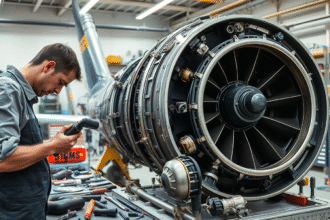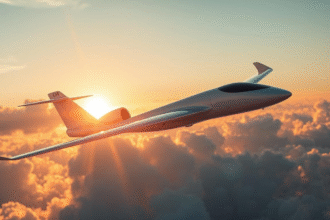You’re about to enter the world of commercial aviation. Here, Boeing and Airbus lead the way. You’ll learn about the competition between these giants.
The commercial aviation world is complex and competitive. Boeing and Airbus are at the top. They have a big share of the market, influencing air travel’s future.
airplane manufaacturing companies
Exploring Boeing and Airbus’s rivalry will show you their strengths and weaknesses. You’ll see their production, technology, and market plans. This comparison will give you a clear view of each company.
Key Takeaways
- Boeing and Airbus dominate the commercial aviation industry.
- The competition between them drives innovation and market growth.
- Their production capabilities and technological advancements are key factors in their success.
- Understanding their market strategies is important for industry stakeholders.
- The rivalry between Boeing and Airbus shapes the future of air travel.
The Duopoly in Commercial Aviation
The duopoly of Boeing and Airbus has deeply shaped the commercial aviation industry. These two giants have dominated for decades. They influence every part of commercial flight.
Market Dominance of Boeing and Airbus
Boeing and Airbus together hold over 90% of the global commercial aircraft market. Their dominance comes from decades of innovation and significant investments in research and development.
Market Share: Boeing has about 43% of the market, while Airbus has around 47%. The rest is shared by smaller manufacturers.
commercial aviation duopoly
The Strategic Importance of Aircraft Manufacturing
Aircraft manufacturing is more than just making planes. It’s about connecting the world and boosting the economy. This industry is key for tourism, trade, and cultural exchange.
Impact on Global Transportation
Boeing and Airbus’s dominance shapes global transportation. They decide on the availability, price, and technology of commercial aircraft. Their production and innovation cycles affect airlines and passenger experiences.
| Aspect | Boeing | Airbus |
| Market Share | 43% | 47% |
| Notable Models | 737, 787 | A320, A350 |
| Innovation Focus | Fuel Efficiency, Passenger Comfort | Fly-by-Wire, Advanced Materials |
Historical Development: From Humble Beginnings to Aviation Giants
Boeing and Airbus have been key players in commercial aviation’s history. They started small but grew into leaders through innovation and vision. Their journey shows the power of hard work and smart planning.
Boeing’s American Aviation Legacy
Boeing began in 1916 with a focus on seaplanes. Over time, it grew into a major player in American aviation. The Boeing 707 in the late 1950s changed air travel. The Boeing 747, the first jumbo jet, followed in the late 1960s.
Airbus: Europe’s Collaborative Aviation Project
Airbus started in the late 1960s through a European partnership. This teamwork helped Airbus compete with Boeing. The A300, the first twin-engine wide-body, was a big step. The A320 family became a hit for its efficiency and flexibility.
Key Milestones in Their Development
Boeing and Airbus have hit many important marks in their histories:
- Boeing: Introduced the 707, developed the 747, and used new materials and tech.
- Airbus: Launched the A300, made the A320 family a success, and created the A380 superjumbo.
These achievements show how competitive and innovative Boeing and Airbus are. They’ve pushed commercial aviation forward.
Boeing vs Airbus history
Corporate Structure and Business Models
Boeing and Airbus dominate the commercial aviation world. Looking at their corporate structures shows how they work efficiently. You’ll learn how these setups affect their strategies and how they compete globally.
Boeing’s Corporate Organization
Boeing is based in the United States and has a traditional setup. The company is split into main areas, like Commercial Airplanes and Defense. This helps Boeing focus on different markets while keeping a wide range of products.
Airbus’s Multinational Structure
Airbus is in Europe and has a complex, international structure. It came from merging European aerospace firms. Airbus has divisions for planes, helicopters, and defense, spread across many countries.
Comparing Management Philosophies
Boeing and Airbus manage differently because of their histories and cultures. Boeing values engineering and making things efficiently. Airbus, being international, focuses on teamwork and flexibility in various markets.
| Criteria | Boeing | Airbus |
| Headquarters Location | United States | Europe |
| Corporate Structure | Traditional Hierarchy | Multinational, Complex |
| Management Philosophy | Emphasis on Engineering and Efficiency | Collaborative, Adaptable |
Knowing these differences helps us understand their competitive tactics. Their structures and models greatly influence their choices and how well they operate.
Major Airplane Manufacturing Companies: Boeing and Airbus Product Lines
Boeing and Airbus lead in making commercial aircraft. They offer a wide range of planes for airlines all over the world.
Boeing’s Commercial Aircraft Portfolio
Boeing has a big selection of planes, from small to big jets. The Boeing 737 family is very popular for its good performance and dependability.
Narrow-body Aircraft (737 Family)
The 737 family has different models like the 737-800 and the 737 MAX. These planes are great for short to medium flights because they use less fuel.
Wide-body Aircraft (747, 767, 777, 787)
Boeing’s big planes include the famous 747 jumbo jet, the 767, the 777, and the 787 Dreamliner. These are made for long trips, giving passengers comfort and saving fuel.
Airbus Commercial Aircraft Range
Airbus also has a wide range of planes, competing with Boeing. The A320 family is a big hit in the narrow-body market.
Narrow-body Aircraft (A220, A320 Family)
The A220 and A320 family give airlines choices for short to medium flights. They focus on saving fuel and making passengers comfortable.
Wide-body Aircraft (A330, A350, A380)
Airbus’s big planes are the A330, the A350 XWB, and the A380. These are for long flights, giving airlines options for carrying many passengers over long distances.
Manufacturing Processes and Production Capabilities
Boeing and Airbus lead the commercial aviation industry. They have invested a lot in making their production systems better. This is to keep up with the demand for more planes.
Boeing’s Production Facilities and Methods
Boeing has big production sites in Everett, Washington, and Charleston, South Carolina. They use new methods like composites and 3D printing. This makes their planes cheaper and more efficient.
For example, Boeing’s Everett facility uses automated systems. This helps make the 787 Dreamliner faster.
Airbus’s Global Manufacturing Network
Airbus has production sites in France, Germany, the UK, and the US. This global network helps them use local skills and cut costs. They also use digital tools like virtual reality in their work.
Supply Chain Management and Challenges
Boeing and Airbus face big challenges in their global supply chains. Getting parts on time is key to keeping production going. They use advanced systems to manage this, like analytics and scorecards.
Production Rates and Efficiency
Boeing and Airbus focus on making more planes without sacrificing quality. Boeing has worked to make the 737 MAX faster. Airbus aims to produce more A320neo planes.
By improving their manufacturing, Boeing and Airbus can meet the demand for planes. They stay ahead in the market.
Technological Innovation and Design Philosophy
Boeing and Airbus lead in technological innovation in commercial aviation. They focus on improving aircraft design and technology. This is seen in their products and research.
Boeing’s Approach to Aircraft Design
Boeing aims to make aircraft efficient, reliable, and comfortable. They invest a lot in research and development. This includes using advanced materials and aerodynamics.
Airbus’s Innovation Strategy
Airbus focuses on fly-by-wire systems, advanced composites, and efficient engines. Their goal is to make aircraft environmentally friendly. They also aim for better performance and passenger experience.
Fuel Efficiency and Environmental Initiatives
Boeing and Airbus work to reduce environmental impact. They use more fuel-efficient engines and lightweight materials. These steps help cut carbon emissions and operating costs.
Cockpit Design and Flight Control Systems
Boeing and Airbus have improved cockpit and flight control systems. Modern cockpits have advanced avionics, touchscreens, and fly-by-wire systems. This enhances pilot experience and safety.
In conclusion, Boeing and Airbus’s success comes from their innovation and design philosophy. Their efforts in technology improve efficiency, safety, and passenger experience.
Market Share and Global Presence
The market share and global presence of Boeing and Airbus are key to their success. They compete in various regions and with different customers.
Regional Strengths and Weaknesses
Boeing and Airbus do well in different places. Boeing is strong in North America. Airbus has a big following in Europe and Asia. Knowing these regional dynamics helps us see how they compete.
| Region | Boeing Market Share (%) | Airbus Market Share (%) |
| North America | 55 | 45 |
| Europe | 30 | 70 |
| Asia | 40 | 60 |
Order Books and Delivery Rates
Boeing and Airbus’s order books and delivery rates show how they’re doing. Airbus has a bigger order backlog. Boeing is focusing on getting planes delivered faster.
Customer Base Analysis
Both companies serve many airlines around the world. Looking at their customers helps us understand their plans and what people want.
Competition in Key Markets
The battle between Boeing and Airbus is intense, mainly in the Asia-Pacific area. They fight by using the latest technology and setting good prices.
Financial Performance and Business Strategies
The aerospace industry is always changing. Boeing and Airbus have different financial plans to stay ahead. Their strategies are based on their history, market, and what customers want.
Revenue and Profitability Comparison
Let’s look at Boeing and Airbus’s money matters. They’ve faced big issues like supply chain problems and demand shifts. These have affected their money.
| Company | Revenue (2022) | Net Income (2022) |
| Boeing | $66.61 billion | $4.89 billion |
| Airbus | $65.45 billion | $4.25 billion |
Investment in Research and Development
Boeing and Airbus spend a lot on research and development. Boeing works on making planes more fuel-efficient and green. Airbus focuses on the next big thing in planes.
Strategic Responses to Market Challenges
Boeing and Airbus tackle market issues differently. Boeing aims to make its supply chain stronger. Airbus works on making planes more efficient.
Government Subsidies and Trade Disputes
Government help and trade fights have big effects on Boeing and Airbus. Trade tensions between the US and Europe are a big challenge. They show the importance of smart financial planning.
Safety Records and Major Incidents
Boeing and Airbus are the top names in commercial aviation. They have had their share of safety issues over time. It’s important to look at their safety records to see how they handle major incidents.
Boeing’s Safety History and Challenges
Boeing has had big problems with its safety, like the 737 MAX Crisis. The crashes of the 737 MAX raised big questions about Boeing’s safety and how it follows rules.
The 737 MAX Crisis
The 737 MAX crisis was very bad, with two crashes that killed many people. It showed problems with the plane’s design and how it was certified.
Response and Reforms
Boeing made big changes after the crisis. It improved its design and testing, trained pilots better, and followed rules more closely. These steps were to make people trust the 737 MAX and Boeing again.
Airbus’s Safety Record
Airbus has had safety issues too, but they were different from Boeing’s. Airbus has worked hard to improve its safety by following rules and using new safety tech.
Some of the key safety innovations include:
- Advanced fly-by-wire systems
- Enhanced pilot training programs
- Regular maintenance and inspection protocols
Airbus is serious about safety. It has strong safety systems and works with regulators to make flying safer for everyone.
Boeing and Airbus keep working to keep flying safe. Their efforts to fix safety problems and make changes are key to making flying safer for all.
Future Outlook: Challenges and Opportunities
Boeing and Airbus are ready to face new challenges and opportunities as the aviation industry recovers. Their strategies will be shaped by market demands, technology, and environmental concerns.
Post-Pandemic Recovery Strategies
Boeing and Airbus are working hard to bounce back. They’re increasing production, investing in new tech, and improving their products to meet customer needs.
Sustainability and Carbon Reduction Goals
Both companies aim to cut their carbon footprint. Airbus is focusing on fuel-efficient planes. Boeing is exploring sustainable fuels and eco-friendly designs.
Emerging Market Competition
New players in the aircraft market are challenging Boeing and Airbus. Companies from China and other emerging markets are making their own planes, shaking up the market.
Next-Generation Aircraft Development
Boeing and Airbus are creating next-generation planes. These will use advanced materials, efficient engines, and new designs. They’re key to meeting future demand and staying ahead.
Urban Air Mobility and New Aviation Segments
Urban air mobility is a new chance for Boeing and Airbus. They’re investing in electric vertical takeoff and landing (eVTOL) aircraft and other innovative solutions.
| Company | Sustainability Goal | Next-Generation Aircraft |
| Boeing | Investing in sustainable aviation fuels | Developing advanced materials and designs |
| Airbus | Pledging to develop more fuel-efficient aircraft | Incorporating more efficient engines and innovative designs |
Boeing and Airbus must adapt to market changes, invest in new tech, and focus on sustainability to succeed.
Conclusion: The Continuing Boeing-Airbus Rivalry
The Boeing-Airbus rivalry is a big part of the commercial aviation world. Both have their own histories, structures, and products. These have shaped how they compete with each other.
This rivalry pushes for better innovation, efficiency, and solutions that meet customer needs. With the industry bouncing back from the pandemic, the demand for planes is going up. This makes the competition between Boeing and Airbus even fiercer.
As the aviation industry keeps changing, Boeing and Airbus will adjust their plans. They will face new challenges and chances. Knowing about this rivalry helps us see where the industry is headed.
The Boeing-Airbus rivalry shows the industry’s dedication to moving forward and making customers happy. Looking ahead, this rivalry will keep driving innovation and growth in commercial aviation.
FAQ
What is the current market share of Boeing and Airbus in the commercial aviation industry?
Boeing and Airbus lead the commercial aviation market, holding over 90% of it. Their exact share can change based on the segment and region.
How do Boeing and Airbus differ in their corporate structures and business models?
Boeing is based in the U.S., while Airbus is in Europe. Boeing has a centralized structure. Airbus, on the other hand, has a global setup with many production sites across Europe.
What are the key differences between Boeing’s and Airbus’s commercial aircraft portfolios?
Boeing’s range includes the 737, 747, 767, 777, and 787. Airbus offers the A220, A320, A330, A350, and A380. Boeing sticks to a traditional design, while Airbus uses advanced tech.
How do Boeing and Airbus approach technological innovation and design philosophy?
Both invest a lot in R&D, aiming to improve fuel efficiency and passenger comfort. Boeing focuses on small steps in innovation. Airbus, though, takes bigger leaps with fly-by-wire systems and new materials.
What are the major challenges facing Boeing and Airbus in terms of safety records and regulatory compliance?
Boeing and Airbus have faced safety issues, like the 737 MAX crisis. They’re working hard to fix these problems and meet safety standards. This includes new safety measures and research.
How are Boeing and Airbus adapting to the changing aviation landscape, including sustainability and carbon reduction goals?
Boeing and Airbus are working to reduce their environmental impact. They’re developing greener planes and exploring new tech like electric propulsion.
What is the outlook for Boeing and Airbus in terms of future growth and competition?
The aviation market is set to bounce back, with Boeing and Airbus ready to grow. They’ll face competition from new markets, sustainability, and next-gen aircraft.
How do Boeing and Airbus differ in their production processes and supply chain management?
Boeing uses a traditional assembly-line method, while Airbus has a global network. Both deal with supply chain issues, like managing global networks and avoiding disruptions.
What are the implications of government subsidies and trade disputes on Boeing and Airbus?
Subsidies and trade disputes can hurt Boeing and Airbus’s competitiveness and profits. They’ve been involved in disputes, with the WTO making rulings on subsidies.







